sensor MAZDA MODEL 3 HATCHBACK 2006 Owner's Manual (in English)
[x] Cancel search | Manufacturer: MAZDA, Model Year: 2006, Model line: MODEL 3 HATCHBACK, Model: MAZDA MODEL 3 HATCHBACK 2006Pages: 372, PDF Size: 5.55 MB
Page 17 of 372
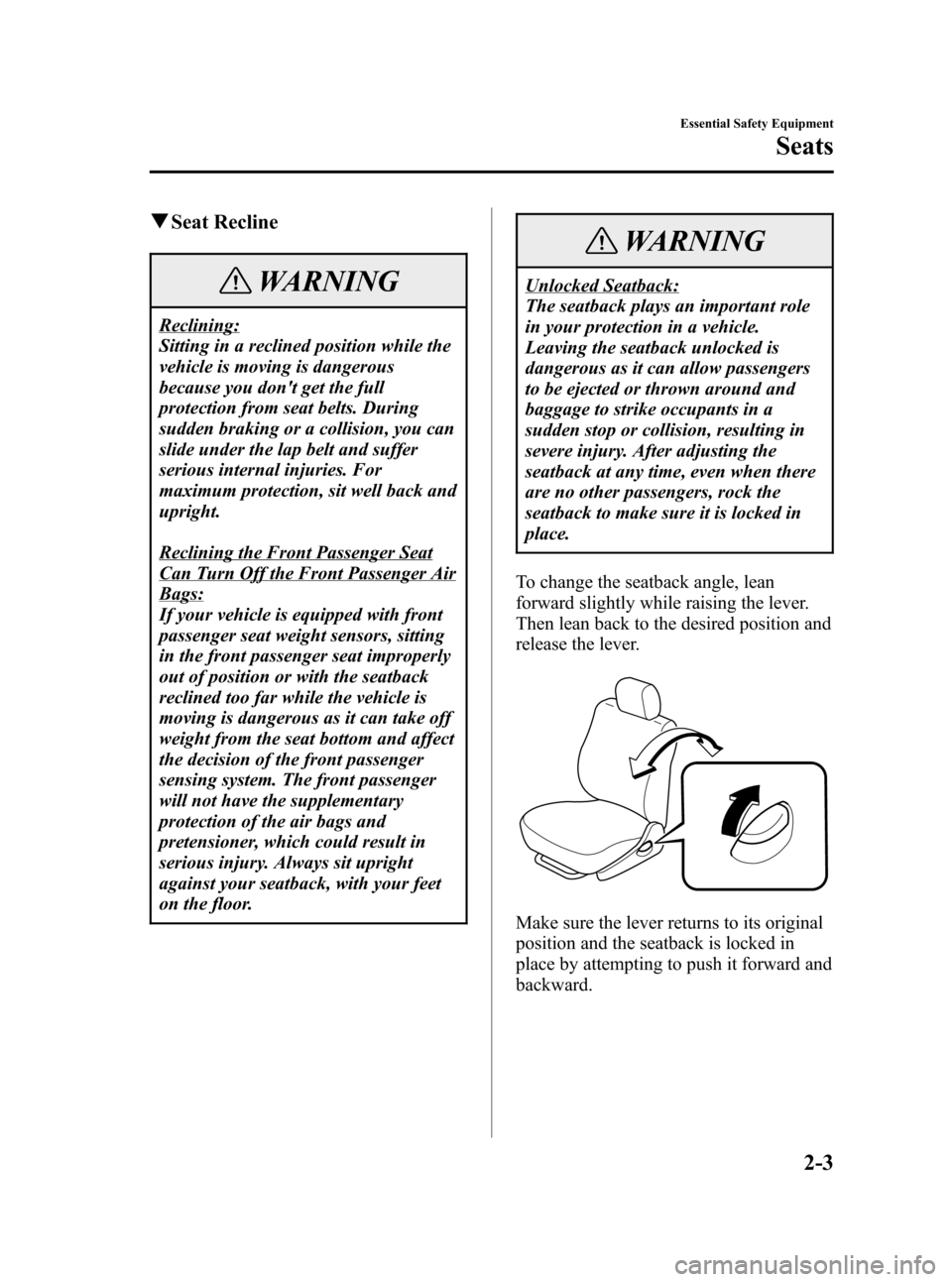
Black plate (17,1)
qSeat Recline
WARNING
Reclining:
Sitting in a reclined position while the
vehicle is moving is dangerous
because you don't get the full
protection from seat belts. During
sudden braking or a collision, you can
slide under the lap belt and suffer
serious internal injuries. For
maximum protection, sit well back and
upright.
Reclining the Front Passenger Seat
Can Turn Off the Front Passenger Air
Bags:
If your vehicle is equipped with front
passenger seat weight sensors, sitting
in the front passenger seat improperly
out of position or with the seatback
reclined too far while the vehicle is
moving is dangerous as it can take off
weight from the seat bottom and affect
the decision of the front passenger
sensing system. The front passenger
will not have the supplementary
protection of the air bags and
pretensioner, which could result in
serious injury. Always sit upright
against your seatback, with your feet
on the floor.
WARNING
Unlocked Seatback:
The seatback plays an important role
in your protection in a vehicle.
Leaving the seatback unlocked is
dangerous as it can allow passengers
to be ejected or thrown around and
baggage to strike occupants in a
sudden stop or collision, resulting in
severe injury. After adjusting the
seatback at any time, even when there
are no other passengers, rock the
seatback to make sure it is locked in
place.
To change the seatback angle, lean
forward slightly while raising the lever.
Then lean back to the desired position and
release the lever.
Make sure the lever returns to its original
position and the seatback is locked in
place by attempting to push it forward and
backward.
Essential Safety Equipment
Seats
2-3
Mazda3_8U55-EA-05G_Edition2 Page17
Thursday, June 23 2005 2:52 PM
Form No.8U55-EA-05G
Page 35 of 372
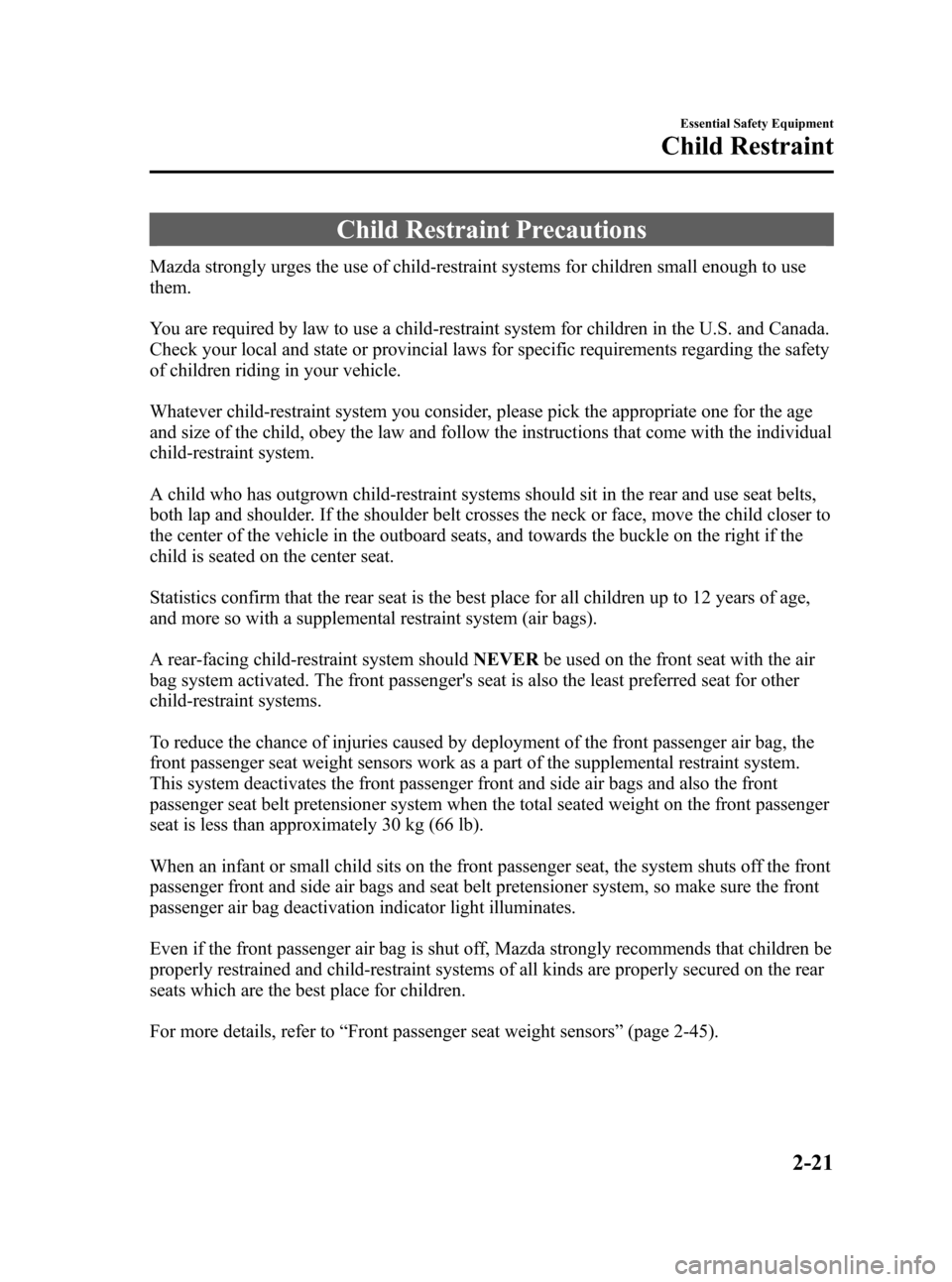
Black plate (35,1)
Child Restraint Precautions
Mazda strongly urges the use of child-restraint systems for children small enough to use
them.
You are required by law to use a child-restraint system for children in the U.S. and Canada.
Check your local and state or provincial laws for specific requirements regarding the safety
of children riding in your vehicle.
Whatever child-restraint system you consider, please pick the appropriate one for the age
and size of the child, obey the law and follow the instructions that come with the individual
child-restraint system.
A child who has outgrown child-restraint systems should sit in the rear and use seat belts,
both lap and shoulder. If the shoulder belt crosses the neck or face, move the child closer to
the center of the vehicle in the outboard seats, and towards the buckle on the right if the
child is seated on the center seat.
Statistics confirm that the rear seat is the best place for all children up to 12 years of age,
and more so with a supplemental restraint system (air bags).
A rear-facing child-restraint system shouldNEVERbe used on the front seat with the air
bag system activated. The front passenger's seat is also the least preferred seat for other
child-restraint systems.
To reduce the chance of injuries caused by deployment of the front passenger air bag, the
front passenger seat weight sensors work as a part of the supplemental restraint system.
This system deactivates the front passenger front and side air bags and also the front
passenger seat belt pretensioner system when the total seated weight on the front passenger
seat is less than approximately 30 kg (66 lb).
When an infant or small child sits on the front passenger seat, the system shuts off the front
passenger front and side air bags and seat belt pretensioner system, so make sure the front
passenger air bag deactivation indicator light illuminates.
Even if the front passenger air bag is shut off, Mazda strongly recommends that children be
properly restrained and child-restraint systems of all kinds are properly secured on the rear
seats which are the best place for children.
For more details, refer to“Front passenger seat weight sensors”(page 2-45).
Essential Safety Equipment
Child Restraint
2-21
Mazda3_8U55-EA-05G_Edition2 Page35
Thursday, June 23 2005 2:53 PM
Form No.8U55-EA-05G
Page 37 of 372
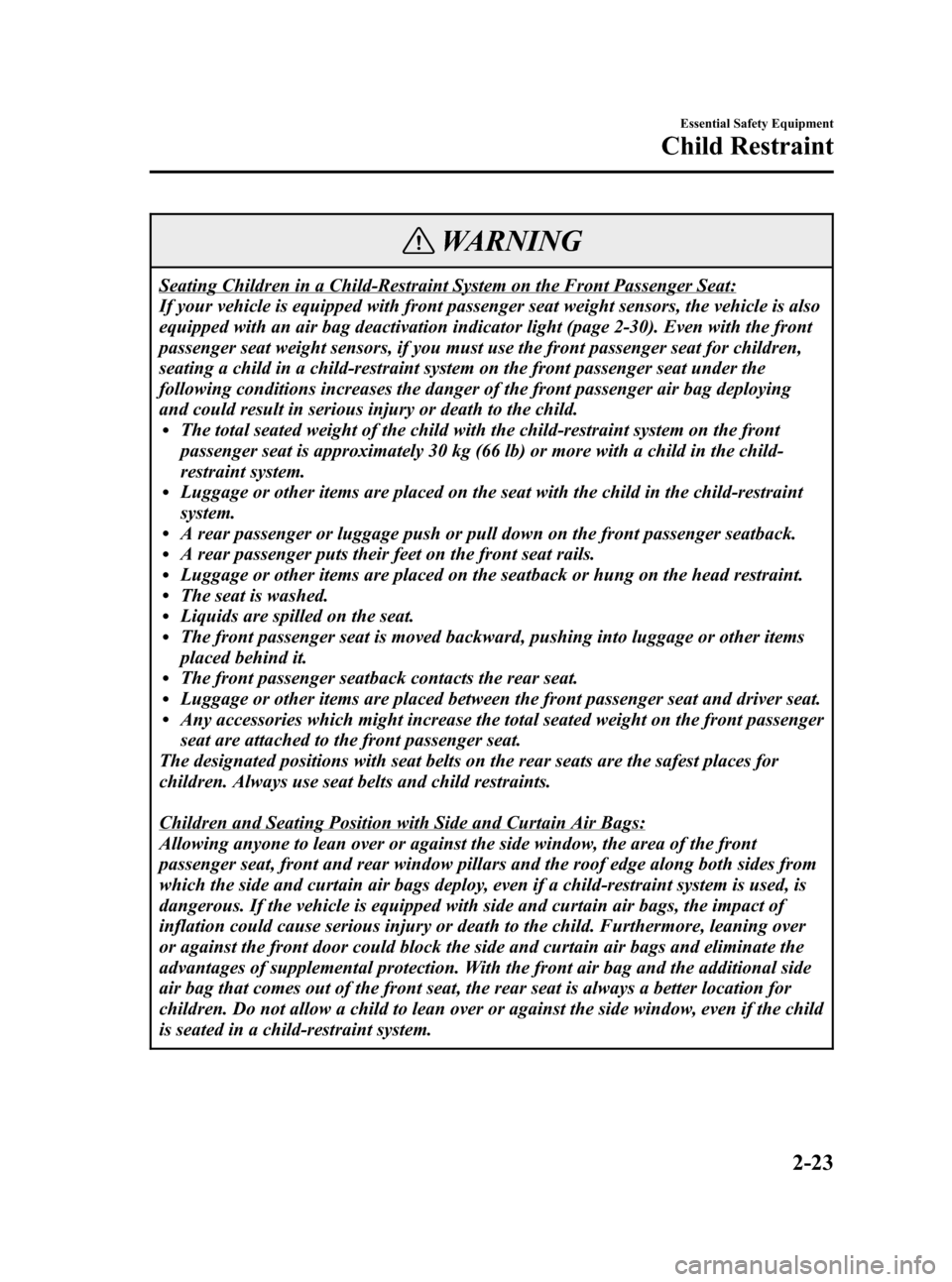
Black plate (37,1)
WARNING
Seating Children in a Child-Restraint System on the Front Passenger Seat:
If your vehicle is equipped with front passenger seat weight sensors, the vehicle is also
equipped with an air bag deactivation indicator light (page 2-30). Even with the front
passenger seat weight sensors, if you must use the front passenger seat for children,
seating a child in a child-restraint system on the front passenger seat under the
following conditions increases the danger of the front passenger air bag deploying
and could result in serious injury or death to the child.
lThe total seated weight of the child with the child-restraint system on the front
passenger seat is approximately 30 kg (66 lb) or more with a child in the child-
restraint system.
lLuggage or other items are placed on the seat with the child in the child-restraint
system.
lA rear passenger or luggage push or pull down on the front passenger seatback.lA rear passenger puts their feet on the front seat rails.lLuggage or other items are placed on the seatback or hung on the head restraint.lThe seat is washed.lLiquids are spilled on the seat.lThe front passenger seat is moved backward, pushing into luggage or other items
placed behind it.
lThe front passenger seatback contacts the rear seat.lLuggage or other items are placed between the front passenger seat and driver seat.lAny accessories which might increase the total seated weight on the front passenger
seat are attached to the front passenger seat.
The designated positions with seat belts on the rear seats are the safest places for
children. Always use seat belts and child restraints.
Children and Seating Position with Side and Curtain Air Bags:
Allowing anyone to lean over or against the side window, the area of the front
passenger seat, front and rear window pillars and the roof edge along both sides from
which the side and curtain air bags deploy, even if a child-restraint system is used, is
dangerous. If the vehicle is equipped with side and curtain air bags, the impact of
inflation could cause serious injury or death to the child. Furthermore, leaning over
or against the front door could block the side and curtain air bags and eliminate the
advantages of supplemental protection. With the front air bag and the additional side
air bag that comes out of the front seat, the rear seat is always a better location for
children. Do not allow a child to lean over or against the side window, even if the child
is seated in a child-restraint system.
Essential Safety Equipment
Child Restraint
2-23
Mazda3_8U55-EA-05G_Edition2 Page37
Thursday, June 23 2005 2:53 PM
Form No.8U55-EA-05G
Page 42 of 372
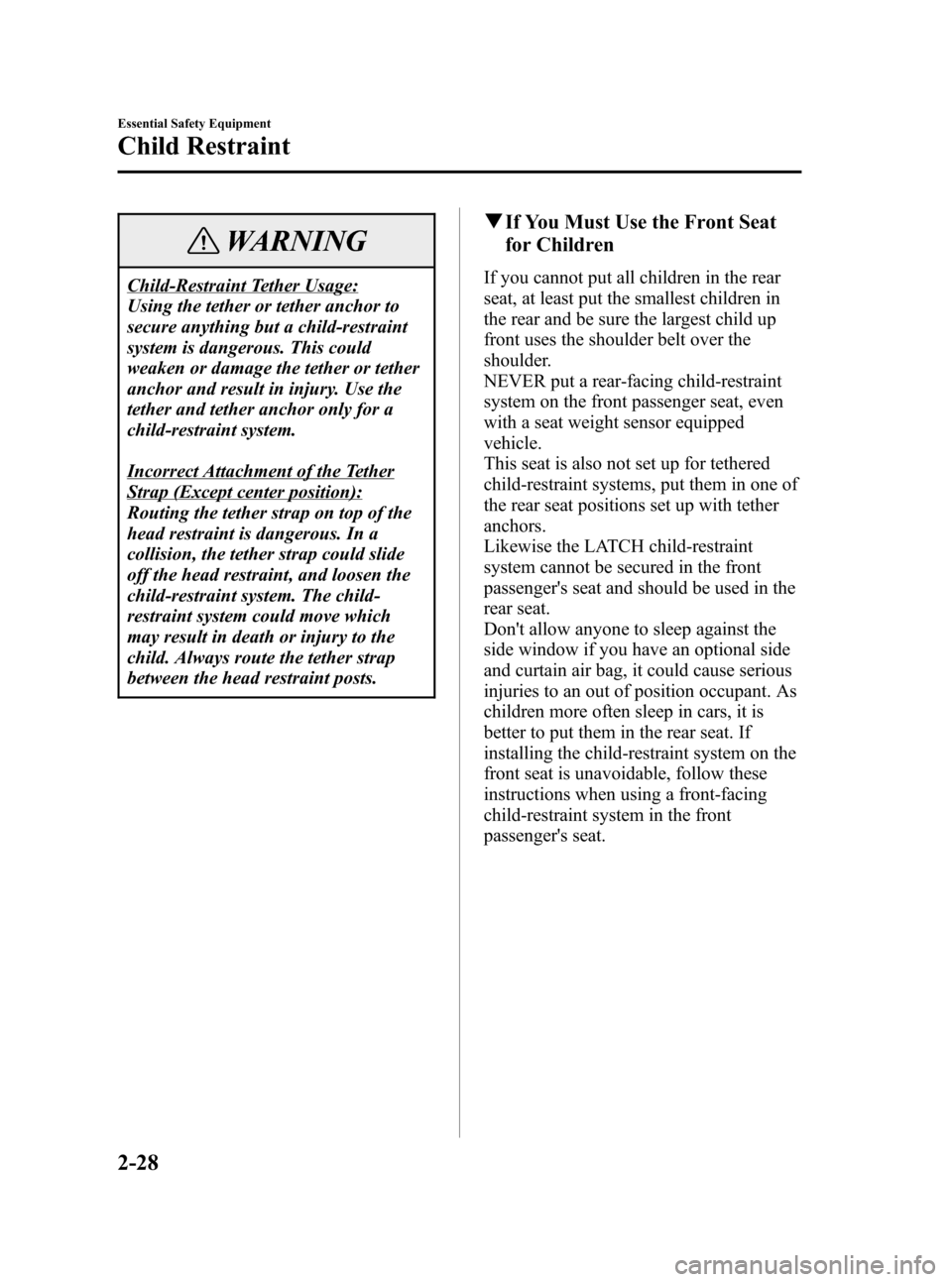
Black plate (42,1)
WARNING
Child-Restraint Tether Usage:
Using the tether or tether anchor to
secure anything but a child-restraint
system is dangerous. This could
weaken or damage the tether or tether
anchor and result in injury. Use the
tether and tether anchor only for a
child-restraint system.
Incorrect Attachment of the Tether
Strap (Except center position):
Routing the tether strap on top of the
head restraint is dangerous. In a
collision, the tether strap could slide
off the head restraint, and loosen the
child-restraint system. The child-
restraint system could move which
may result in death or injury to the
child. Always route the tether strap
between the head restraint posts.
qIf You Must Use the Front Seat
for Children
If you cannot put all children in the rear
seat, at least put the smallest children in
the rear and be sure the largest child up
front uses the shoulder belt over the
shoulder.
NEVER put a rear-facing child-restraint
system on the front passenger seat, even
with a seat weight sensor equipped
vehicle.
This seat is also not set up for tethered
child-restraint systems, put them in one of
the rear seat positions set up with tether
anchors.
Likewise the LATCH child-restraint
system cannot be secured in the front
passenger's seat and should be used in the
rear seat.
Don't allow anyone to sleep against the
side window if you have an optional side
and curtain air bag, it could cause serious
injuries to an out of position occupant. As
children more often sleep in cars, it is
better to put them in the rear seat. If
installing the child-restraint system on the
front seat is unavoidable, follow these
instructions when using a front-facing
child-restraint system in the front
passenger's seat.
2-28
Essential Safety Equipment
Child Restraint
Mazda3_8U55-EA-05G_Edition2 Page42
Thursday, June 23 2005 2:53 PM
Form No.8U55-EA-05G
Page 55 of 372

Black plate (55,1)
WARNING
Hot Air Bag Inflators:
Hot air bag inflators are dangerous. Immediately after inflation, the inflators in the
steering wheel, dashboard, seatbacks, or the front and rear window pillars and along
the roof edge are very hot. You could get burned. Don't touch the internal components
of the air bag modules after the bags have inflated.
Installation of Front-End Equipment:
Installation of front-end equipment, such as frontal protection bar (kangaroo bar, bull
bar, push bar, etc.), snowplow, or winches, is dangerous. The air bag crash sensor
system could be affected. This could cause air bags to inflate unexpectedly, or it could
prevent the air bags from inflating during an accident. Front occupants could be
seriously injured. Never install any front-end equipment to your vehicle.
Suspension Adjustment:
Adjusting the vehicle suspension is dangerous. If the vehicle's height or the
suspension is changed, the vehicle will be unable to accurately detect a collision
resulting in incorrect or unexpected air bag deployment and the possibility of serious
injuries.
Modification of the Supplemental Restraint System:
Modifying the components or wiring of the supplemental restraint system is
dangerous. You could accidentally activate it or make it inoperable. Don't make any
modifications to the supplemental restraint system. This includes installing trim,
badges, or anything else over the air bag modules. It also includes installing extra
electrical equipment on or near system components or wiring. An Authorized Mazda
Dealer can provide the special care needed in the removal and installation of front
seats. It is important to protect the air bag wiring and connections to assure that the
bags do not accidentally deploy, the driver seat slide position sensor and front
passenger seat weight sensors are not damaged and that the seats retain an
undamaged air bag connection.
NOTE
lWhen an air bag deploys, a loud inflation noise can be heard and some smoke will be
released. Neither is likely to cause injury, however, the texture of the air bags may
cause light skin injuries on body parts not covered with clothing through friction.
lShould you sell your Mazda, we urge you to tell the new owner of its air bag systems
and that familiarization with all instructions about them, from the Owner's Manual, is
important.
Essential Safety Equipment
SRS Air Bags
2-41
Mazda3_8U55-EA-05G_Edition2 Page55
Thursday, June 23 2005 2:53 PM
Form No.8U55-EA-05G
Page 56 of 372
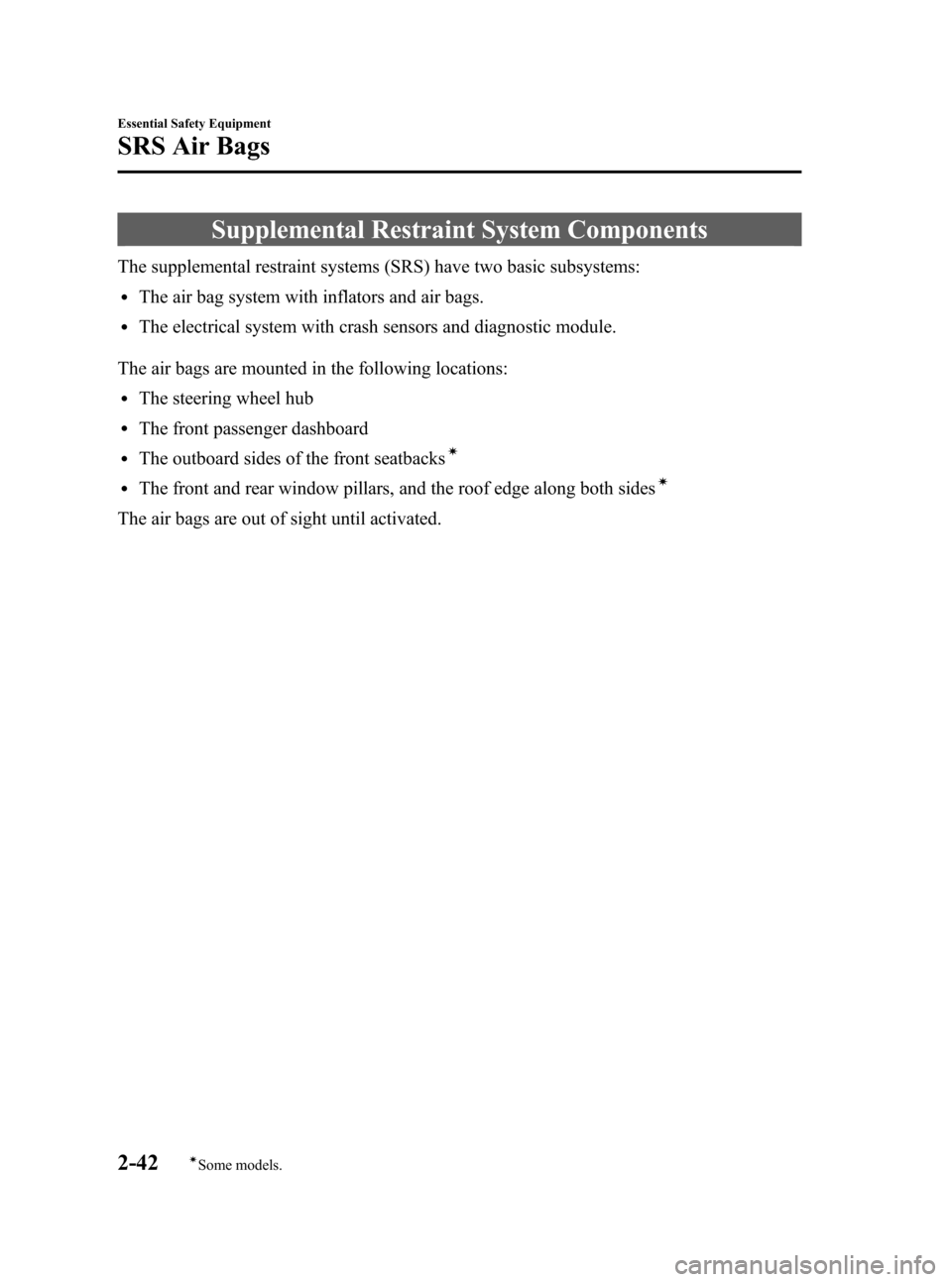
Black plate (56,1)
Supplemental Restraint System Components
The supplemental restraint systems (SRS) have two basic subsystems:
lThe air bag system with inflators and air bags.
lThe electrical system with crash sensors and diagnostic module.
The air bags are mounted in the following locations:
lThe steering wheel hub
lThe front passenger dashboard
lThe outboard sides of the front seatbacksí
lThe front and rear window pillars, and the roof edge along both sidesí
The air bags are out of sight until activated.
2-42
Essential Safety Equipment
íSome models.
SRS Air Bags
Mazda3_8U55-EA-05G_Edition2 Page56
Thursday, June 23 2005 2:53 PM
Form No.8U55-EA-05G
Page 57 of 372

Black plate (57,1)
qFront Air Bag System Components
(1)
(6)
(10)
(7)
(6) (9)(5)(4) (3) (2)
(8)
(1) Driver seat slide position sensor (page 2-45)
(2) Front seats
(3) Front dual stage inflators and air bags
(4) Front air bag sensor
(5) Front passenger air bag deactivation indicator light (page 2-45)
(6) Front seat belt pretensioner and load limiting systems (page 2-14)
(7) Front passenger seat weight sensors (page 2-45)
(8) Front passenger seat weight sensor control module
(9) Crash sensors and diagnostic module (SAS unit)
(10) Driver and front passenger seat belt buckle switches (page 2-45)
Essential Safety Equipment
SRS Air Bags
2-43
Mazda3_8U55-EA-05G_Edition2 Page57
Thursday, June 23 2005 2:53 PM
Form No.8U55-EA-05G
Page 58 of 372
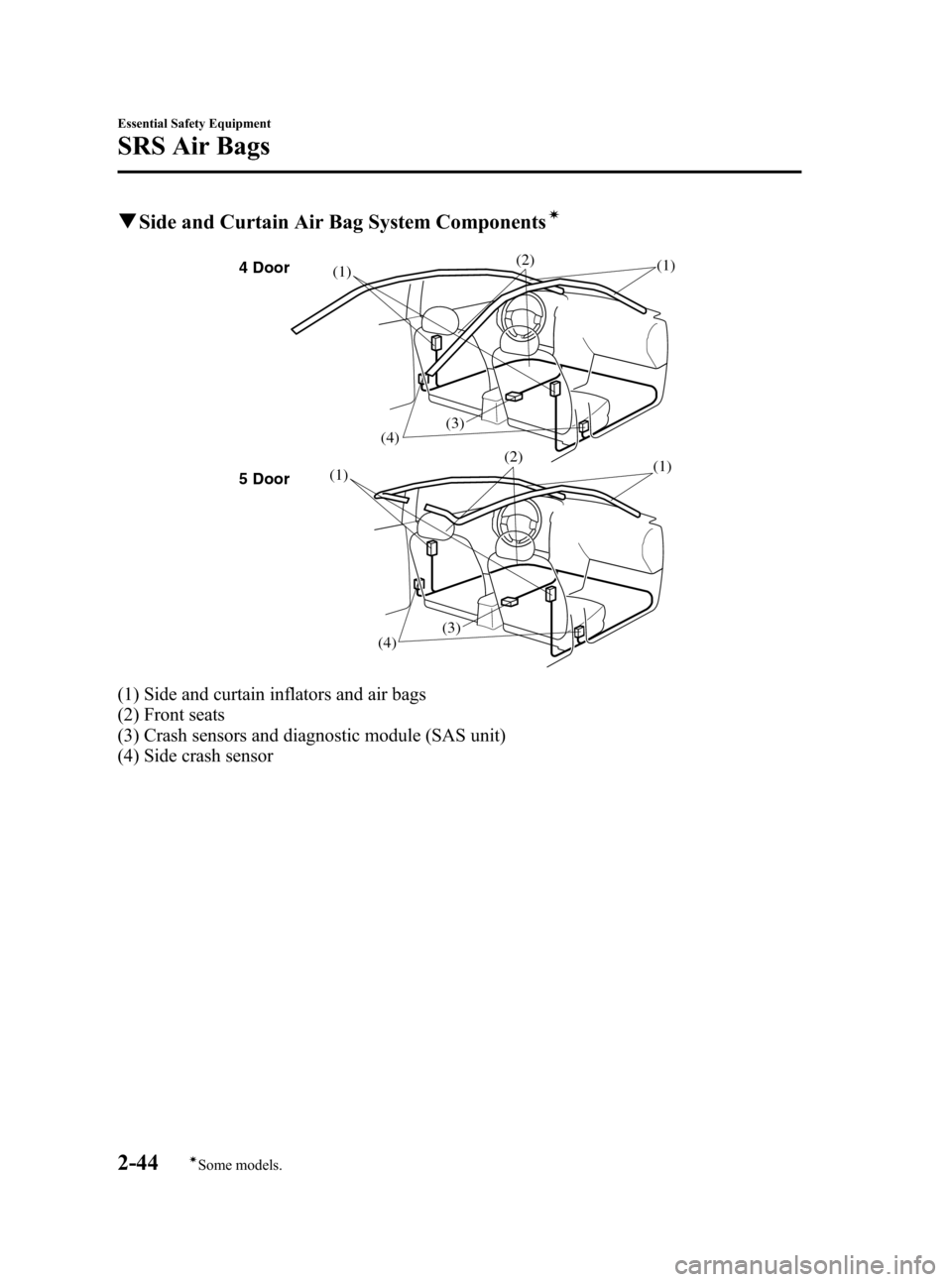
Black plate (58,1)
qSide and Curtain Air Bag System Componentsí
4 Door
5 Door(4) (1)(1)
(3)(2)
(3)
(4) (1)(1) (2)
(1) Side and curtain inflators and air bags
(2) Front seats
(3) Crash sensors and diagnostic module (SAS unit)
(4) Side crash sensor
2-44
Essential Safety Equipment
íSome models.
SRS Air Bags
Mazda3_8U55-EA-05G_Edition2 Page58
Thursday, June 23 2005 2:53 PM
Form No.8U55-EA-05G
Page 59 of 372
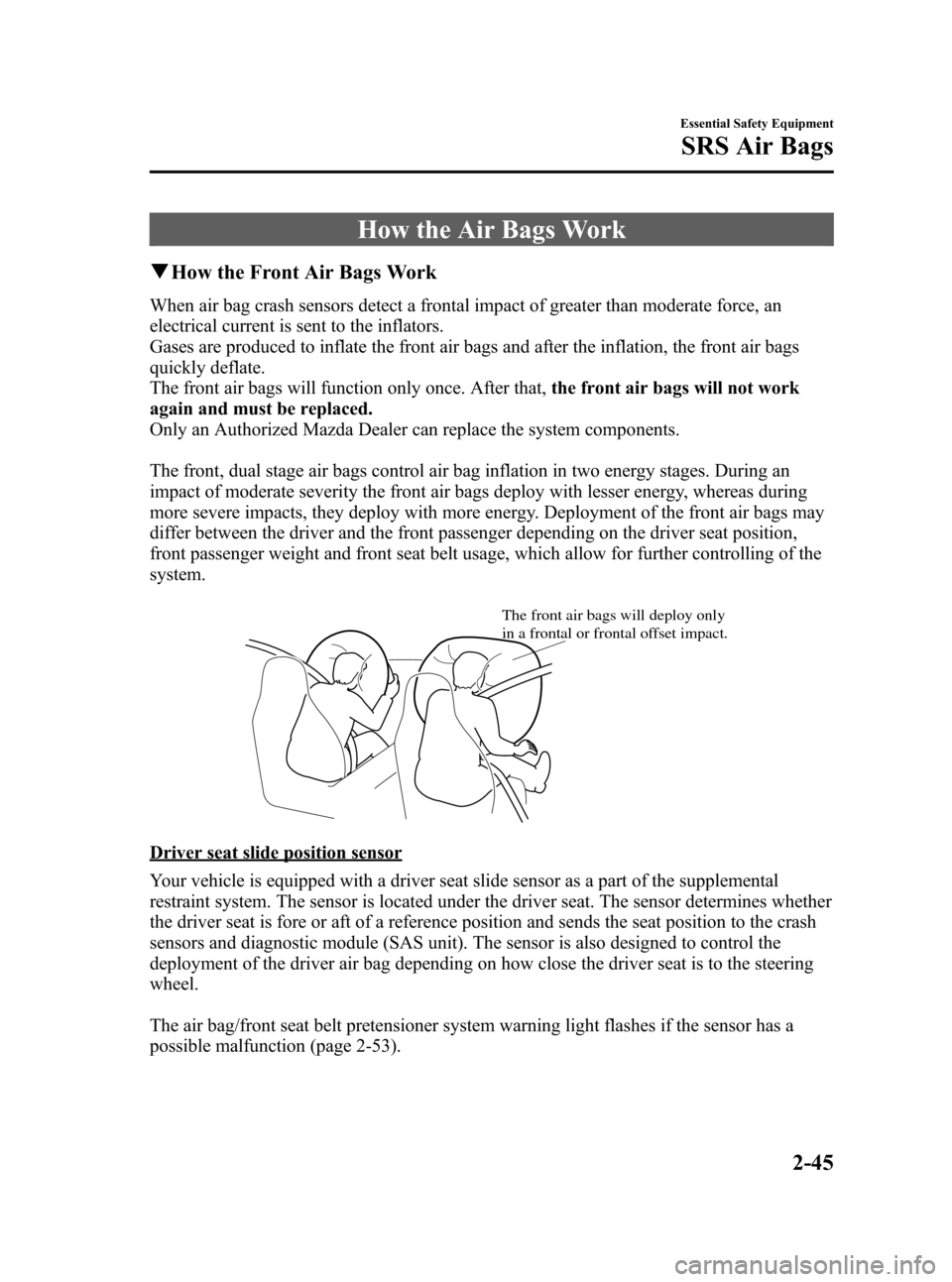
Black plate (59,1)
How the Air Bags Work
qHow the Front Air Bags Work
When air bag crash sensors detect a frontal impact of greater than moderate force, an
electrical current is sent to the inflators.
Gases are produced to inflate the front air bags and after the inflation, the front air bags
quickly deflate.
The front air bags will function only once. After that,the front air bags will not work
again and must be replaced.
Only an Authorized Mazda Dealer can replace the system components.
The front, dual stage air bags control air bag inflation in two energy stages. During an
impact of moderate severity the front air bags deploy with lesser energy, whereas during
more severe impacts, they deploy with more energy. Deployment of the front air bags may
differ between the driver and the front passenger depending on the driver seat position,
front passenger weight and front seat belt usage, which allow for further controlling of the
system.
The front air bags will deploy only
in a frontal or frontal offset impact.
Driver seat slide position sensor
Your vehicle is equipped with a driver seat slide sensor as a part of the supplemental
restraint system. The sensor is located under the driver seat. The sensor determines whether
the driver seat is fore or aft of a reference position and sends the seat position to the crash
sensors and diagnostic module (SAS unit). The sensor is also designed to control the
deployment of the driver air bag depending on how close the driver seat is to the steering
wheel.
The air bag/front seat belt pretensioner system warning light flashes if the sensor has a
possible malfunction (page 2-53).
Essential Safety Equipment
SRS Air Bags
2-45
Mazda3_8U55-EA-05G_Edition2 Page59
Thursday, June 23 2005 2:53 PM
Form No.8U55-EA-05G
Page 60 of 372
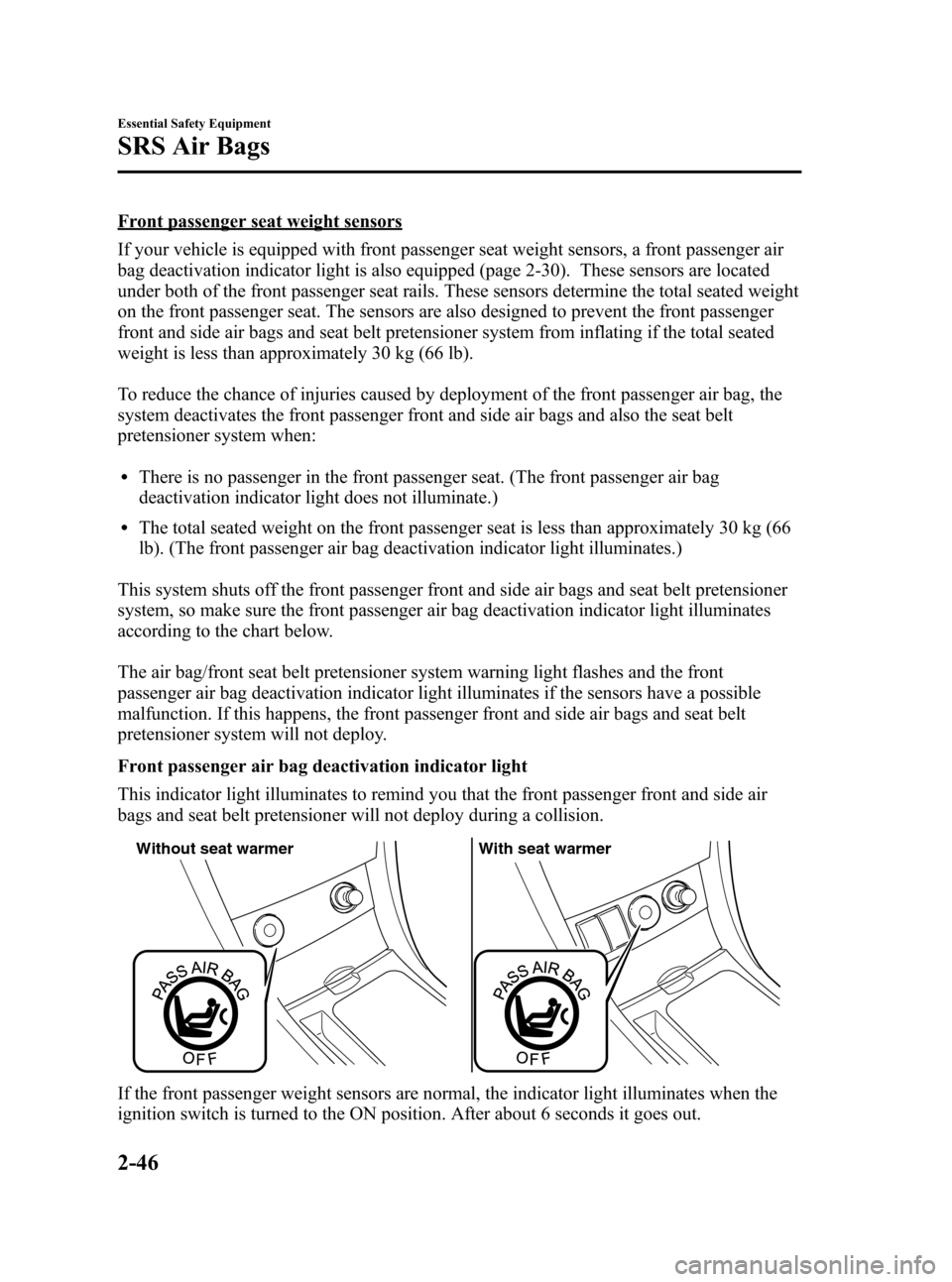
Black plate (60,1)
Front passenger seat weight sensors
If your vehicle is equipped with front passenger seat weight sensors, a front passenger air
bag deactivation indicator light is also equipped (page 2-30). These sensors are located
under both of the front passenger seat rails. These sensors determine the total seated weight
on the front passenger seat. The sensors are also designed to prevent the front passenger
front and side air bags and seat belt pretensioner system from inflating if the total seated
weight is less than approximately 30 kg (66 lb).
To reduce the chance of injuries caused by deployment of the front passenger air bag, the
system deactivates the front passenger front and side air bags and also the seat belt
pretensioner system when:
lThere is no passenger in the front passenger seat. (The front passenger air bag
deactivation indicator light does not illuminate.)
lThe total seated weight on the front passenger seat is less than approximately 30 kg (66
lb). (The front passenger air bag deactivation indicator light illuminates.)
This system shuts off the front passenger front and side air bags and seat belt pretensioner
system, so make sure the front passenger air bag deactivation indicator light illuminates
according to the chart below.
The air bag/front seat belt pretensioner system warning light flashes and the front
passenger air bag deactivation indicator light illuminates if the sensors have a possible
malfunction. If this happens, the front passenger front and side air bags and seat belt
pretensioner system will not deploy.
Front passenger air bag deactivation indicator light
This indicator light illuminates to remind you that the front passenger front and side air
bags and seat belt pretensioner will not deploy during a collision.
With seat warmer Without seat warmer
If the front passenger weight sensors are normal, the indicator light illuminates when the
ignition switch is turned to the ON position. After about 6 seconds it goes out.
2-46
Essential Safety Equipment
SRS Air Bags
Mazda3_8U55-EA-05G_Edition2 Page60
Thursday, June 23 2005 2:53 PM
Form No.8U55-EA-05G